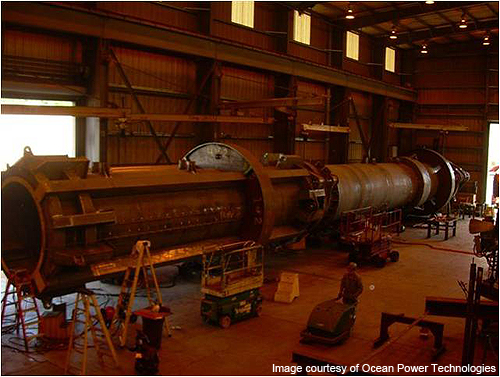forum
library
tutorial
contact

US Makes Waves as Marine Power Gains Popularity
by StaffInternational Water Power & Dam Construction, October 16, 2012
|
the film forum library tutorial contact |

|
US Makes Waves as Marine Power Gains Popularityby StaffInternational Water Power & Dam Construction, October 16, 2012 |
 Collaborations between the US power industry and academia to develop new technologies for marine power generation are closer than ever before, states a new report by business information specialist GlobalData.
Collaborations between the US power industry and academia to develop new technologies for marine power generation are closer than ever before, states a new report by business information specialist GlobalData.
The new report -- Marine Power (Wave and Tidal) -- Installed Capacity, Levelized Cost of Energy (LCOE), Profiles of Technology Developers and Key Country Analysis to 2030 - shows that the US is working to conduct extensive testing of wave and tidal power devices in open waters, while various universities are working to develop marine technologies.
All ocean energy research in the US is consolidated under the Naval Facilities Command (NAVFAC) and the US Navy has continued its support. The Water Power Program by the US Department of Energy (US DOE) has invested more than $87M in marine and hydrokinetic development projects, and aims to collaborate with universities, laboratories, industry and other agencies working on marine technology in the US to commercially develop and deploy marine technology for power generation.
Electric Power Research Institute (EPRI) estimates the total annual average wave energy off the US coast, calculated at a depth of 60m, at 2,610 terawatt-hours (TWh) per year, with Alaska and the western coast contributing for more than 80% of this. Several projects are planned to capture the energy potential in US waters, and over 80 marine energy projects are in various stages of development, though no tidal power plants are currently commercially active -- the US has only one commercially active wave power plant, with 1 megawatt (MW) capacity.
Approximately 50 tidal projects are in various stages of development throughout the US, with many based in Alaska and California. Oregon is the leading generator of hydroelectric power in the US, with close to 300 MW of planned projects lined up for development by Finavera Renewables, Oceanlinx Limited and Ocean Power Technologies, and the neighboring coast of California is also a potential site for wave energy. The state boasts more than 1,200km of coastline and a combined annual average deep water power flux of over 37,000 MW, of which at least 20% can be converted into electricity. The potential of wave energy is sufficient to meet at least 20% of in-state electricity consumption. There are three 100 MW plants planned in both Oregon and California, along with other smaller projects.
On the east coast of the US, Maine and New Jersey have suitable conditions for marine energy development. The states of Washington, California, Alaska, Hawaii, Massachusetts and Oregon also hold potential for ocean energy to be harnessed, and Hawaii is a favorable site for ocean thermal energy conversion.
learn more on topics covered in the film
see the video
read the script
learn the songs
discussion forum
